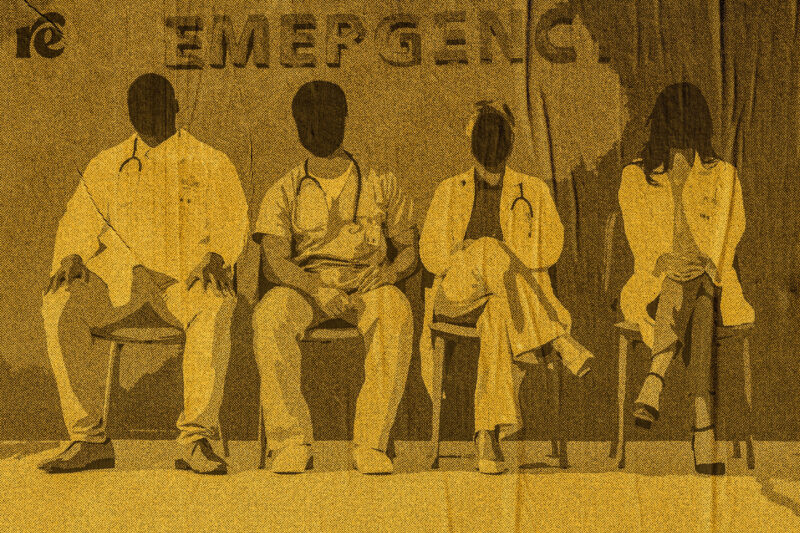I’m an ER Doctor. If the Supreme Court Upends EMTALA, Patients Will Die.
Thanks to EMTALA, emergency room doctors are trained to treat life-threatening pregnancy-related emergencies. That treatment needs to include an abortion.

I am an emergency medicine doctor. My job is to save lives. The destruction of the Emergency Medicine Treatment and Active Labor Act (EMTALA) would make this job impossible.
EMTALA, which Congress passed in 1986, ensures doctors like me cannot turn away anyone from the emergency room until we know it is safe to do so. More specifically, it ensures that anyone who visits a hospital receiving Medicare funding is screened and medically stabilized, regardless of their ability to pay.
Pregnancy complications, such as an ectopic pregnancy or a septic miscarriage, can be life threatening. They may require procedures (like dilation and evacuation, or D&E) or medication that anti-choice groups claim should be illegal. States with increasingly restrictive abortion laws have been battling over what can and cannot be done without violating EMTALA. If the pregnant person’s life is at risk, providers are legally obligated to perform these procedures to stabilize them.
The Supreme Court will hear oral arguments today for the case in Idaho that argues that these life-saving procedures are only necessary when a pregnant person is on the edge of death—and not before. In the ER, we know stabilizing treatment includes abortion. Idaho wants to argue it does not.
Without EMTALA, patients lives are at risk
I work in Illinois, which has statewide legal protections for abortion care. Our neighboring states of Indiana and Wisconsin do not. Indiana, in fact, has some of the most restrictive abortion laws. I have treated too many patients who live in Indiana and have had to cross state lines to get the basic care they need. Many of these pregnant people experience miscarriages while traveling. Many pregnant people in Idaho or other restrictive states do not have the luxury of proximity to safe care. They are at risk.
Meeting with ER colleagues from states such as Idaho has shown that ER providers have been running uphill since the Supreme Court overturned Roe v. Wade in 2022. The laws dictating what we can and cannot do to help our patients seem to change daily. Every legal challenge of new laws makes our place in this changed world even more confusing. But EMTALA made sure we could count on providers to do the right thing, which is to save the lives of our patients in danger. We meet so we can plan—what can they do? What is legal right now? What training can we give fellow ER providers to help their patients in crisis?
OB-GYNs are already fleeing states with increasingly restrictive abortion laws. This terrifies me.
Simply put, pregnancy can be dangerous. In the ER, we are trained to recognize and treat life-threatening pregnancy-related emergencies. We stabilize so an OB-GYN can perform procedures or give medication necessary to save lives. I have resuscitated too many women whose hearts have stopped beating because they were bleeding so much internally from ectopic pregnancies. I have watched as a young woman hemorrhaged from an active miscarriage that could only be saved in an operating room, keeping her alive until the specialist could arrive.
The abortion ban in question in Idaho currently allows for exemptions for ectopic pregnancies. However, if EMTALA is no longer valid in these cases, our patients are no longer protected. The case claims that abortion care can only be performed when absolutely necessary—and not a minute before.
I have treated these cases, and that moment hangs on a knife’s edge. Women can go from stable and bleeding to unstable or dead within minutes. Uninformed anti-choice lawmakers with no medical knowledge are creating these laws. They have not seen what I have seen. Protecting only ectopic pregnancies and ignoring other life-threatening pregnancy risks is short-sighted and, frankly, dangerous.
We are watching reproductive health care crumble around us, leaving patients stranded and in very real crises. The risk is not only from the lack of access to necessary medical stabilization, but also leaving pregnant people with no one to treat them after.
EMTALA ruling will have ripple effects
OB-GYNs are already fleeing states with increasingly restrictive abortion laws. This terrifies me. I will try to stabilize whoever walks in my door, but I’m not a surgeon or a gynecologic specialist. I can’t perform surgery, so I count on those who can. My ER colleagues in Idaho and Texas feel hopeless. What are we doing if we cannot get our patients the care they need?
This ruling could also have a domino effect on EMTALA’s further destruction—it would change health care for everyone, regardless of the state they live in. EMTALA states that an ER has to evaluate and stabilize anyone who comes in, regardless of ability to pay or citizenship status (among other factors). It is not difficult to imagine hospital systems turning away undocumented immigrants or those without health insurance post-EMTALA. The hospitals I work at are in underserved communities, and many of them struggle with receiving payment from patients who are disenfranchised from medical care. If a hospital is no longer required to stabilize these patients, who is? My hospitals are entrenched in the opioid epidemic, and many patients I see are unhoused and uninsured, brought in for life-threatening overdoses. If they can’t pay and are no longer protected by EMTALA, what happens to them?
I will be watching the Supreme Court closely as arguments unfold and the justices ultimately issue a decision. I will be hoping for the best but preparing for the worst. In the meantime, I will go to work—both in the hospital and out—to give patients the health care and life-saving treatment they need and deserve.
